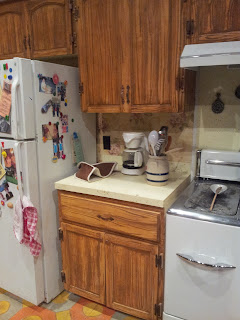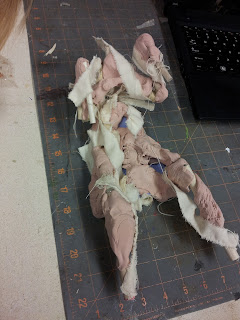There aren't a lot of specific projects to show you here, but I wanted to share the pictures with you. Partially to show the level of detail that should be considered to make set dressing feel real, and partially because I'm really proud of it and want to show it off.
The majority of the food in the pantry was donated by members of the company. We placed boxes out in multiple locations for people to put things in, and my intern collected them daily and cleaned out things that needed to be cleaned.
The sideboard was found on craigslist. It was filled with nice china from stock, the cookbooks were from the thrift store, and the strawberry jars were filled with real rice, sugar and flour.
The photo wall in the hallway was a combination of stock photos, images sent to us by the actors of them as children, and of their families, and pictures of the designers and their families to fill in the blanks.We ended up needing to hang the photos three times. Once my assistant did it, but it looked pretty sloppy. Then I did it, and thought I was doing a much better job making the spacing even finally we did it together and created this arrangement. It turns out it was very important to continually have someone stepping back to look at the larger picture, which was impossible to do with one person, standing up close, holding the frames and screwing them in.
I included this other shot of the same wall mostly just to show the little glade plug-in in the wall outlet.
The photos on the outside of the fridge were also of the cast, designer, director and our families. Some of the magnets were purchased, some were found at thrift stores, and some were created by searching stock and craft bins and attaching anything small and interesting to a magnet with hot glue.
Any cabinet that was opened during the action of the show had to be fully dressed. The audience saw very little of what was inside as the cabinet only opened for a moment, but it was important that the moment felt as natural as possible.
The costume designer helped me pull a couple jackets and coats from stock that could have believably belonged to the characters.
We added Buffalo Sabers and Bills "stickers" to the window on the back door.
Most of the containers inside the fridge were also donated. The jam jars were just ball jars filled with scrap fabric and water. I also used casserole dishes and a bowl covered with tin foil to fill space.
The butter in the previous image is just a slice of upholstery foam tucked into the butter dish
My favorite pieces on this shelf are the recipe box and junk bowl (filled with keys, some buttons, a few screws and bolts, tic tacs and nail polish) on the top shelf
Other than the herbs and the curtains in this photo, notice the windchime outside the window
The cookie jar is part of a subtle strawberry theme in the kitchen. I find it helpful to pick a theme like this to help direct my set dressing purchases, and to give a set some personality.
When set dressing, I think there should always be some pens (this time in a jar with the american flag), and a pad of paper or two by the phone.















































